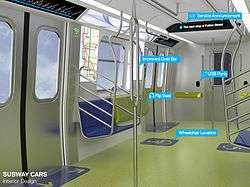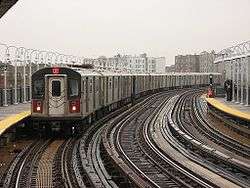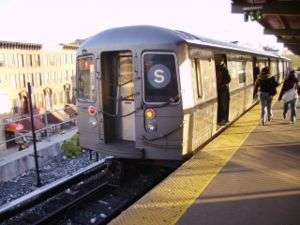R211 (New York City Subway car)
| R211 | |
|---|---|
|
Rendering of the proposed exterior of an R211 | |
| Manufacturer | TBA |
| Replaced |
|
| Number under construction |
0 (in planning) (1025 proposed) (1545 with all options exercised) |
| Number built | 0 (in planning) |
| Fleet numbers | TBA |
| Operator(s) | |
| Specifications | |
| Train length |
5-car train: 301.05 feet (91.76 m) 10-car train: 602.1 feet (183.5 m) |
| Car length | 60.21 feet (18.35 m) |
| Width | TBD |
| Height | TBD |
| Doors | 8 per car |
| Maximum speed | TBD |
| Prime mover(s) | electric motor |
| Electric system(s) | 600 V DC Third rail |
| Current collection method | Contact shoe |
| Braking system(s) | TBD |
| Safety system(s) | emergency brakes |
| Track gauge | 1,435 mm (4 ft 8 1⁄2 in) standard gauge |
The R211 is a future new technology (NTT) New York City Subway car for the B Division. The MTA will invest $2.956 billion in this 1,025-car order.[1] These future cars are anticipated to replace the remaining R32s, all R44s on the Staten Island Railway and possibly all remaining R46s.
Component orders
The contract's project totals 1025 cars, or 1545 with all options exercised, that will all be linked in 5-car sets. The contract is split into three parts: R211A, R211S, and R211T. The base order of 285 cars will comprise 10 R211T open-gangway prototype cars, 75 R211S cars to replace the remaining 63-car R44 fleet on the Staten Island Railway, and 200 R211A cars that will partially replace the 752 aging R46 cars as well as R32s that are not replaced by the R179s.[2] There will be an option for either 740 R211A or R211T cars, depending on the success of the prototype R211T.[3] These cars would finish replacing the older R32s and R46s. There would also be one additional option for up to 520 cars, meaning that the total number of cars in the fleet could total 1545.[4] Any additional cars not replacing existing rolling stock will be used to expand the system's fleet.[5][6] The R211Ts will be designed to increase capacity and allow passengers to walk seamlessly from one car to the next.[1][7][8][5][9]
Features


The doors on the R211s will be 58 inches (150 cm) wide, wider than the current MTA standard of 50 inches (130 cm), thereby projected to reduce station dwell time by 32%. This design change partially incorporates part of the design of the R110A prototype subway cars, which have doors that are 63 inches (160 cm) wide.[10] The new cars will have Wi-Fi installed, USB chargers, digital advertisements, digital customer information displays, illuminated door opening alerts, and security cameras,[3][11] unlike the current New Technology Trains, which lack these features.[12] It was announced in July 2016 that the cars would have open gangways that allowed passengers to move between cars during train movement.
There will be a change in exterior appearance from previous New Technology Trains as well. The subway cars will have a blue front with large windows, LED headlights, and a blue strip with gold accents on the sides, similar to the new MTA Regional Bus Operations livery released in 2016. To designate the route, a large LED screen with the route bullet will be displayed at the ends of the train similar to trains with rollsigns; in addition, the route's destination will be displayed above the door on the front. Updated FIND displays would be installed. The seating on the inside will be blue and gold. Flip seats will be installed to allow for space for wheelchairs.[3][11] There will also be looped stanchions, a feature found in R160As 9798-9802 and all R179s.
History
The R211 Design Master Plan was approved by the MTA in December 2011, and design planning began in December 2012.[7][13] An R211 solicitation was posted in the classified section of Metro Magazine's May 9, 2013 issue, stating the proposal to acquire these cars in the near future. At the time, the order was planned to be 75 feet (23 m) in length, the same length as the R46 cars. Open-gangways, which would allow passengers to seamlessly walk throughout the train or units, and other alternate configurations were also initially considered for the entire order.[14]
By the release of the MTA's 2015-2019 Capital Program in October 2015, the order specified 60-foot (18 m) cars, which has been the standard length of new B Division cars since the R143 order. As of March 2016, open-gangways will be tested on ten cars (now designated as the R211T).[1][8] Additionally, the order was broken up into a base order of 565 R211A cars and two option orders: the first for 375 R211A cars, and a second for up to 520 R211As.[1][8][5][6][14]
The Request for Proposal (RFP) was issued on July 22, 2016 and the contract will be put out for bidding.[7][8][3][4] With the RFP, the break up of the order was changed. The base order is now 285 cars, with 10 R211T cars, 75 R211S cars, and 200 R211A cars. There will still be two option orders, but the first option order will contain 740 cars, either R211As or R211Ts based on whether the R211Ts in the base order are successful in their testing. The second base order will still contain 520 cars.[4] The contract is expected to be awarded in early 2017,[7] at which time the existing R46 fleet will be 42 years old, and the existing R32 fleet will be 53 years old.[lower-alpha 1]
Notes
- ↑ The R46s were first delivered in 1975, and the R32s were first delivered in 1964, which makes them 42 and 53 years old respectively.
References
- 1 2 3 4 "MTA Capital Program 2015-2019" (PDF). mta.info. Metropolitan Transportation Authority. October 28, 2015. Retrieved 28 October 2015.
- ↑ "R34211 NOTICE -OF- ADDENDUM ADDENDUM #3" (PDF). mta.info. Metropolitan Transportation Authority. August 11, 2016. Retrieved August 15, 2016.
- 1 2 3 4 "Governor Cuomo Unveils Design of Reimagined MTA Subway Cars and Details Ambitious Plan to Enhance Subway Stations". 2016-07-18. Retrieved 2016-07-19.
- 1 2 3 "NON-CONSTRUCTION CONTRACT SOLICITATION NOTICE R34211 Purchase of 1025 Subway Cars" (PDF). mta.info. Metropolitan Transportation Authority. July 22, 2016. Retrieved July 24, 2016.
- 1 2 3 "Review of the A and C Lines" (PDF). Metropolitan Transportation Authority. December 11, 2015. Retrieved 19 January 2016.
- 1 2 "MTA Twenty-Year Capital Needs Assessment 2015-2034" (PDF). Metropolitan Transportation Authority. October 2013. Retrieved 11 August 2015.
- 1 2 3 4 "MTA Capital Program Oversight Committee Meeting: January 2016" (PDF). mta.info. Metropolitan Transportation Authority. January 2016. Retrieved January 23, 2016.
- 1 2 3 4 "Transit & Bus Committee Meeting - March 2016" (PDF). Metropolitan Transportation Authority. Metropolitan Transportation Authority. March 21, 2016. Retrieved March 19, 2016.
- ↑ Rivoli, Dan (August 13, 2015). "Ancient subway trains on C and J/Z lines won't be replaced until 2022, documents say". Daily News (New York). Retrieved 25 November 2015.
- ↑ "www.nycsubway.org: R-110 New Technology Test Program". www.nycsubway.org. Retrieved 2016-07-19.
- 1 2 "MTA renderings" (PDF). www.governor.ny.gov. July 18, 2016. Retrieved July 18, 2016.
- ↑ "NYC, meet your (possible) subway cars of the future". am New York. Retrieved 2016-04-25.
- ↑ "Capital Program Oversight Committee Meeting: October 2012" (PDF). Metropolitan Transportation Authority. October 2012. Archived from the original (PDF) on 2013-11-02. Retrieved 24 January 2016.
- 1 2 "New York City Transit: R211 - New Generation of Subway Cars". Metro Magazine, MTA New York City Transit. May 2013. Retrieved 25 November 2015.
External links
| Wikimedia Commons has media related to R211 (New York City Subway car). |
- MTA Capital Program 2015-2019 (page 15)
- R211 digital mock (page 18)
- R211 Design Concepts
- Contract proposal as of March 18, 2016



